Table of Contents |
The period covered in this lesson begins in the seventh century and ends in the 13th century AD. The geographical region covered is Japan, a country consisting of four large islands with numerous smaller islands, and located just east of mainland China.
Below is a timeline highlighting the period covered in this lesson.
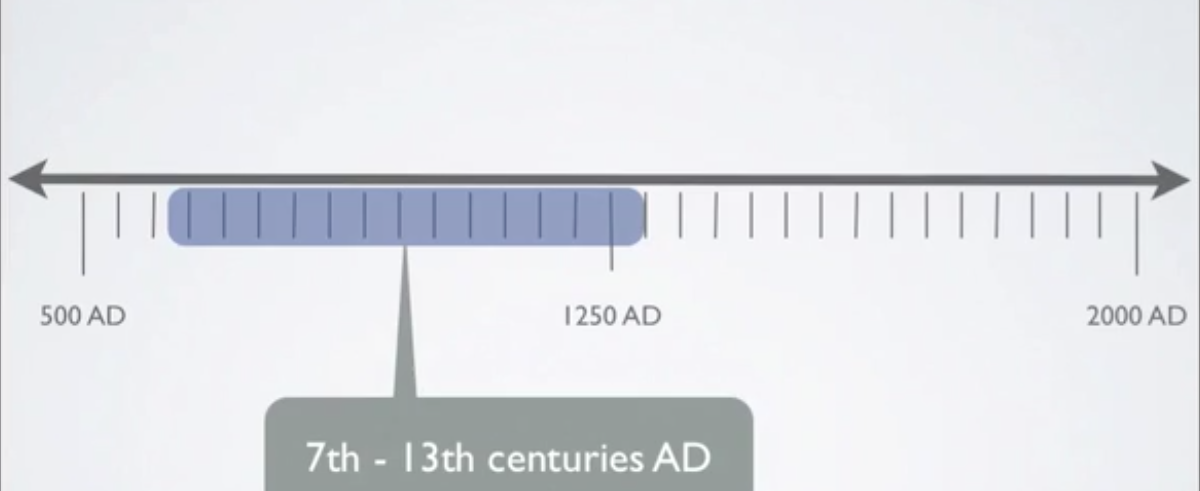
China’s culture deeply influenced Japan in many ways, influencing its writing system, religion, and elements of the royal court. In particular, the Japanese culture copied Chinese Buddhism very closely.
Below is our first example of Japanese architecture.
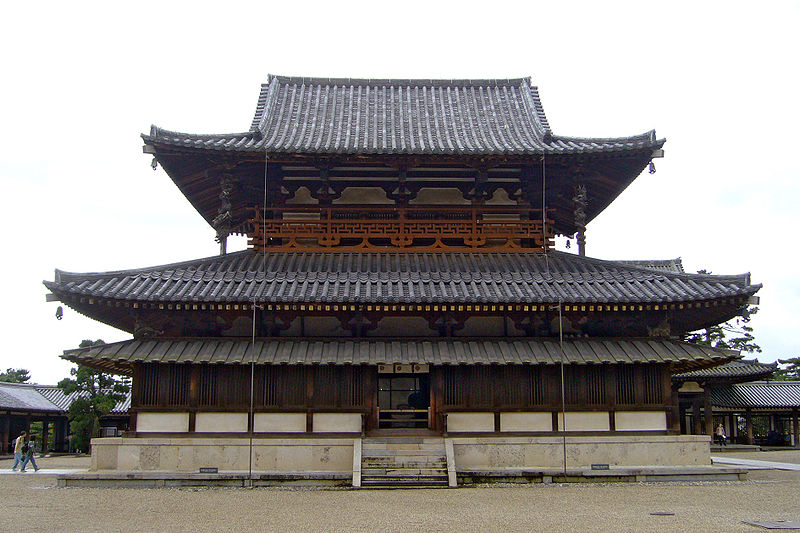
7th century AD
Wood
Nara Prefecture, Japan
This piece of architecture is from the Horyuji Buddhist temple complex in the Nara Prefecture in Japan. This is a kondo, which is the main hall in a Buddhist temple. It was originally built during the seventh century AD, and has been rebuilt a few times, although its core remains as it was. In fact, it is the oldest surviving example of a wooden building in existence.
The Horyuii Kondo has several formal similarities to Chinese pagodas:
This next image is of a bronze Buddha.
623 AD
Bronze
Nara Prefecture, Japan
The above sculpture, the “Shaka Triad” from 623 AD, is located within the Horyuji complex, and is a bronze triad, a common Buddhist depiction of a central Buddha figure flanked by two bodhisattvas. It was created by the artist known as Tori Bushi. “Bushi” means “maker of Buddhist images.” Here the figures are depicted with elongated heads and highly stylized folds within the robes.
The central Buddha is Shaka, which is the historical Buddha, as opposed to one of his many manifestations. He is seated in the meditative Lotus position, with his right hand in a specific type of mudra, or gesture, called the “fear not” gesture. Behind the Buddha is a highly stylized flaming mandorla.
This next image is of the “Yakushi Triad,” from the late seventh or early eighth centuries.
Late 7th to early 8th centuries AD
Bronze
Nara Prefecture, Japan
It shows a stylistic influence of mainland China’s Tang dynasty. The artist takes care to render the forms in a much more realistic manner. The clothing isn’t as overtly stylized as it is in the Tori Bushi triad. Instead, it clings to the forms and reveals the body definition underneath.
Notice the contrapposto-like stance of the nearest bodhisattva figure. According to scholars, this stylistic influence can be traced back to the Indian influence on the stylistic conventions of China, which were then borrowed by Japan. This itself may have been the influence of cultural exchange between India and Greece during the reign of Alexander the Great.
During the Heian period in Japan, the court moved the capital to Kyoto. It was a time of extended peace and prosperity, and during this time a lady of the court, known as Lady Murasaki, wrote the first graphic novel in history.
EXAMPLE
This image is from Murasaki’s 11th century AD literary work, The Tale of Genji.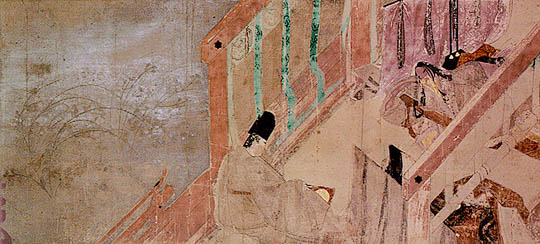
The image is a major insight into the courtly life of an 11th century aristocrat, told through the main character, Prince Genji. The scholarly language of the time was Chinese, but Tale was written in a more common form called Hiragana script. Hiragana script was often used by women, as it was thought to be easier than other forms of Japanese writing. Keep in mind this was a contemporary opinion.
Works of writing such as this were not considered equal to poetry, so it’s very likely this would’ve been looked at as nothing more than a novelty in its time.
The above image is a scene from the talk from The Tale of Genji. Interestingly, these stories are told from the perspective of the reader, who views the characters from above at an angle inside a building, thanks to the roof being blown off. This is typical Japanese stylistic preference. Also similar is the way in which emotions are conveyed through color, symbolism, poses, and overall composition.
During the Heian period, Esoteric Buddhism became the main form of Buddhism. It emphasized complex hierarchies of gods, which were depicted in mandalas such as the Womb World Mandala, shown here:
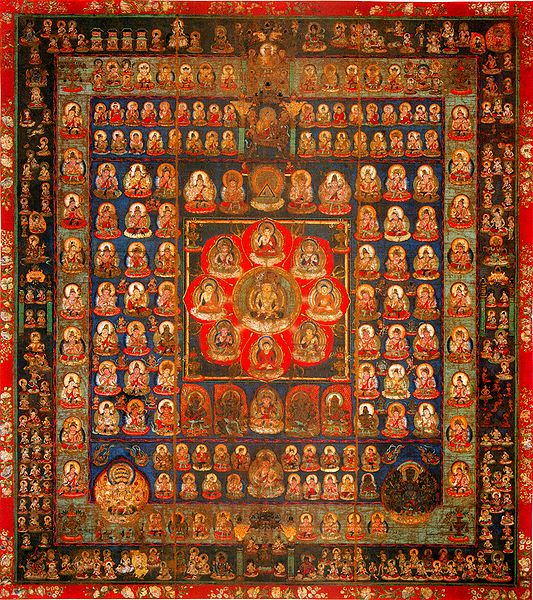
Second half of 9th century AD
Color on silk
Kyoto, Japan
Pure Land Buddhism remained popular during the Kamakura period in Japan. The late 12th century through the early to mid-13th century set the foundation for feudalism in Japan. Pure Land Buddhism emphasizes the importance of the Amida Buddha and the path to salvation that is achieved by committing oneself to the salvation of Amida Buddha.
During this time, speedy descent images of the Buddha became popular, depicting Amida Buddha shooting down from the clouds to help someone in need, usually a dying person. This next image, however, is an image of the Amida descending slowly over the mountains. Obviously, speedy is a relative term.
EXAMPLE
Below is an image of the Amida Buddha descending slowly over the mountains.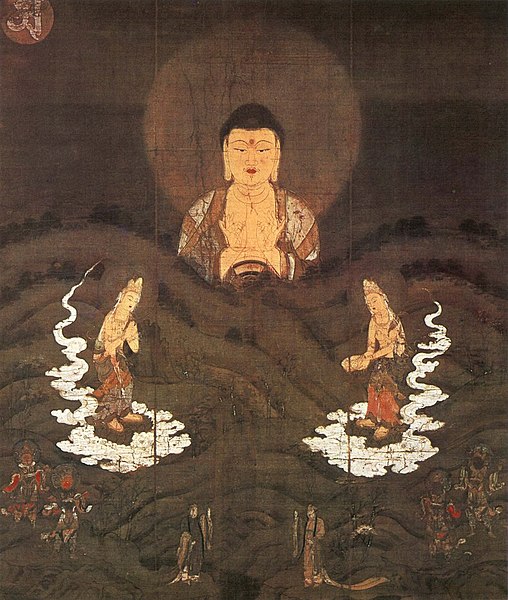
The pure land of Pure Land Buddhism referred to a paradise, of sorts, created by one of Buddha’s manifestations. The Phoenix Hall, located in Kyoto, Japan, uses careful stylistic details such as:
EXAMPLE
Below is the Phoenix Hall.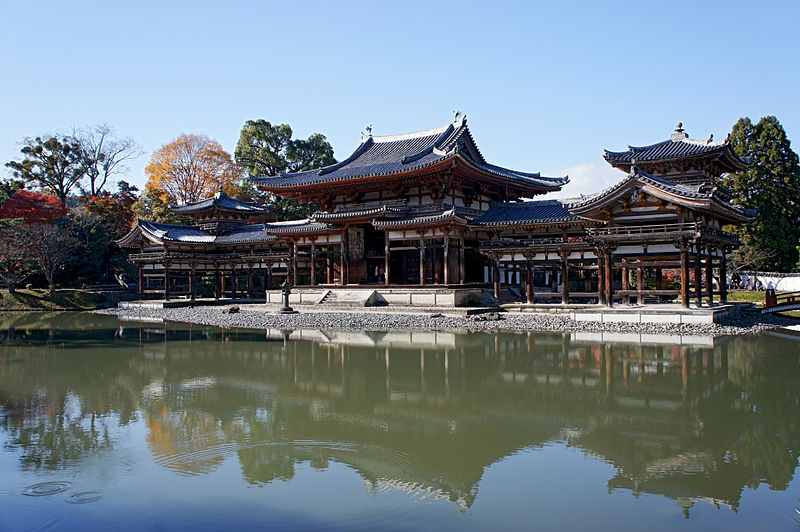
Source: THIS TUTORIAL WAS AUTHORED BY IAN MCCONNELL FOR SOPHIA LEARNING. Please see our Terms of Use.